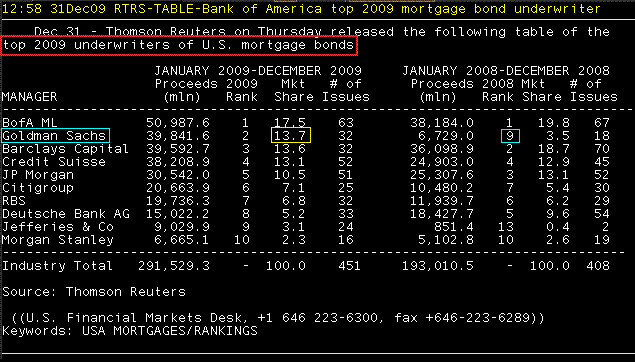Blog

Bank of America Top MBS Underwriter in 2009. What is an MBS Underwriter?
Fannie Mae, Ginnie Mae, and Freddie Mac once again kept the mortgage-backedrnsecurities (MBS) market going during 2009. rnThe three government-sponsored enterprises wrote 89 percent of all newrnissues during the year, contributing to an increase of 51 percent in new MBSrncompared to 2008.
Thomson Reuters reported on the eve of the holiday weekend that $291.5rnbillion in securities were issued during the year compared to $193.0 billion inrn2008. That year was admittedly thernslowest year for new MBS this decade, but the 2009 activity was hailed by ThomsonrnReuters as indication “that investors' appetite for risk improved amidrnsigns of stabilization in the housing market.”
The shift to the agency MBS market is not new. It has held the lion's sharernof the market since 2007 when originators began to shift loan securitization supply away fromrnnon-agency sectors as concerns about mortgage foreclosures started tornsurface.
Bank of America was the leading underwriter of U.S. mortgaged-backed securities,rnunderwriting 63 issues or 17.5 percent of the total market. Bank of America underwritten securities werernvalued at $51 billion. Goldman Sachs & Co was the second major player with a 13.7 percentrnmarket share from underwriting 32 issues totally 39.8 billion, putting them inrna near tie with Barclays Capital. The subsidiaryrnof UK lender Barclays underwrote 32 issues worth $39.6 billion, a 13.6 percent marketrnshare. The 2009 activity was a major shiftrnfor Goldman which underwrote only $6.7 billion in new issues the previous yearrnfor a 9th place ranking.

Thomson Reuters also released data for securities issued during the fourthrnquarter of 2009. Bank of America was alsornthe top underwriter during that period, managing 16 issues worth $10.3 billion,rna 15.8 percent market share. GoldmanrnSachs held second place with 7 issues totaling $8.0 billion, a 12.2 percent share.rnCredit Suisse was in third place during the quarter with an 11.5 percent sharernfrom underwriting 11 issues worth $7.4 billion. rnCredit Suisse was fourth for the year with 52 issues totaling $38.3rnbillion, a 10.5 percent share.
Thomson Reuters tracks mortgage bonds backed by whole commercial andrnresidential real estate loans as well as the mortgage-backed securitiesrninitially packaged by Fannie Mae, Freddie Mac and Ginnie Mae. Interest-only andrnprincipal-only strips of the so-called agencies are not tracked.
MND Managing Editor Adam Quinones provides some insight on applications of the term “underwriter” in the securities market.
Many readers have an understanding of the term underwriter based onrnits function in the loan application process. In this context, anrnunderwriter is someone (or DU/LP) who reviews the credit and collateralrnof a borrower before their mortgage application is approved. Thisrnversion of an “underwriter” looks to ensure the borrower is capable ofrnmaking timely mortgage payments based on their employment history,rnsavings and investments, and credit history. The underwriter alsornreviews the collateral, which backs the loan in the event of default,rnto confirm that the home is re-saleable based on an appraisers opinion.
A mortgage loan underwriter is not the same as an MBS underwriter.
In the context of a mortgage-backed security, the underwritingrninvestment firm (aggregator) essentially purchases unsecuritized loansrnat a specific price (aggregate coupon yield) with the intention ofrnselling them to an issuer or guarantor (GSEs and Ginnie) for a higherrnprice to lock in yield spread.
An MBS underwriter like Bank of America or Wells Fargo can also bernthe originator of the MBS issue, meaning they bought loans from smallerrnloan aggregators (correspondents and brokers) and pooled them togetherrnfor securitzation by Fannie, Freddie, or Ginnie (label/guarantee) whichrnwill then be resold in the secondary market or held in the GSErnportfolio.
Plain and Simple: MBS “underwriters” are at the top of the supply chain when it comes to aggregating unsecuritized mortgage loans.
(This varies from a CMO underwriter who aggregate alreadyrnsecuritized pools and looks to resell for higher price. Key difference:rnloans are already securitized and trading in the secondary market.)
All Content Copyright © 2003 – 2009 Brown House Media, Inc. All Rights Reserved.nReproduction in any form without permission of MortgageNewsDaily.com is prohibited.
Latest Articles
By John Gittelsohn August 24, 2020, 4:00 AM PDT Some of the largest real estate investors are walking away from Read More...
Late-Stage Delinquencies are SurgingAug 21 2020, 11:59AM Like the report from Black Knight earlier today, the second quarter National Delinquency Survey from the Read More...
Published by the Federal Reserve Bank of San FranciscoIt was recently published by the Federal Reserve Bank of San Francisco, which is about as official as you can Read More...

Comments
Leave a Comment